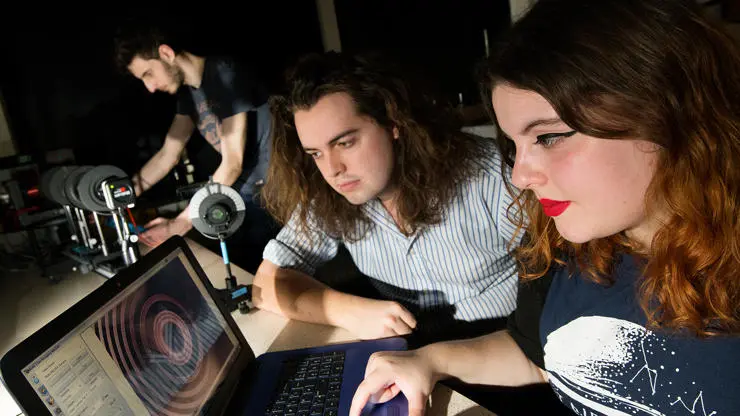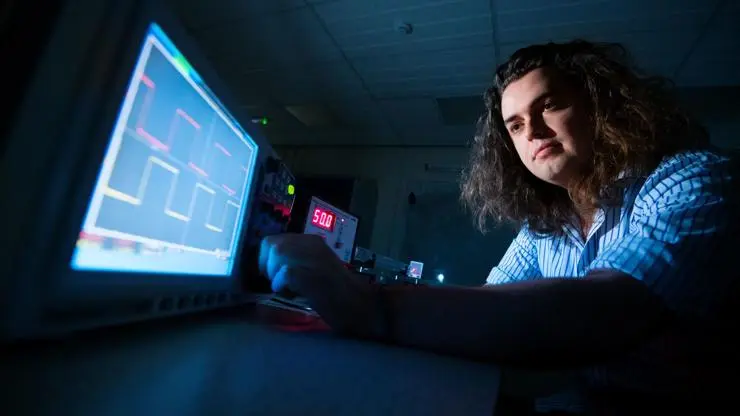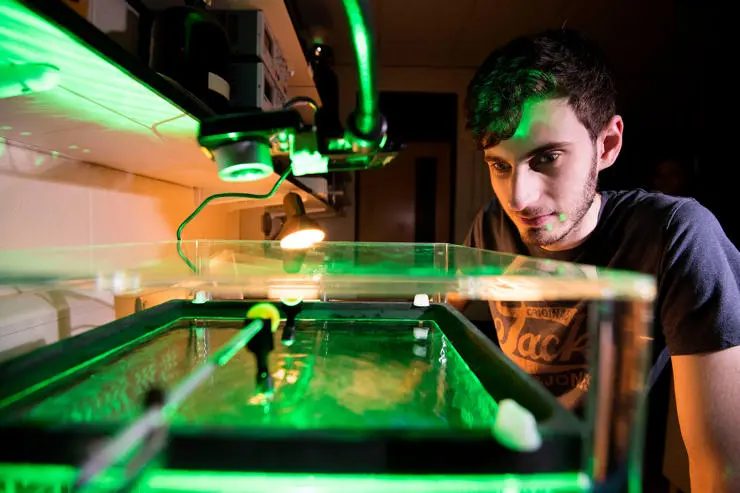Physics

Perform cutting-edge research with our Research Groups. Each 12 month project is unique, as the frontiers of research advance.
The physics group’s active research themes include:
- Nanophysics
- Energy technologies
- Quasicrystals
- Molecular electronics
- Strongly correlated systems
- Magnetism and magnetic materials
- Crystal growth
- Ionic liquids
- Solar energy
- Graphene
You will take part in the day-to-day activity of an active research group. Here you'll complete a research project designed by you in collaboration with the group leader. You'll use the latest world-class equipment to perform research in your chosen topic. You'll also have personal guidance from one of our world-leading academic staff.
Research is open-ended in nature. It will be up to you to follow interesting leads and draw conclusions. You'll also benefit from the experience and skill of your supervisor, who will always be available to suggest next steps. We’ll equip you with research skills and the potential to advance knowledge and practice within your chosen field.
The nature of the work means that you will gain a great deal of broad experience. From technical expertise to networking skills and project management. Such experience is in great demand from employers, as it shows that you have the ability to take ownership of a project and drive it to completion.
Why study with us
- This year-long course gives insights to life as a researcher - excellent preparation for a future research career or alternatively for a wide range of sectors.
- You'll benefit from one-on-one supervision and gain access to cutting-edge facilities.
- Compared to typical taught postgraduates degrees, you'll pay the lowest fees.
Current projects
A research project is not necessarily rigid and may evolve as it develops, and as you develop your understanding. If you have an idea for a new project and think one of our academics is a good fit to supervise it, please contact them. Our academic contact details can be found on their staff profiles, linked in the project titles below.
Carbon-60 is the famous football-shaped carbon allotrope. Many wonderful things have been done with this hollow molecule. Including filling it with other atoms, and swapping out atoms in the cage for other atoms. We have access to samples of some of these materials, including C59N and C84Sc3.
This project is to investigate these materials using:
- Scanning tunnelling microscopy (STM)
- Low-energy electron diffraction (LEED).
You'll use state-of-the-art equipment to investigate the interactions of these materials. With substrates of technological interest, generating and analysing atomic-resolution data.
This is a cutting-edge fundamental physics study with relevance to:
- Solar cell
- Smart materials
- Information technology.
Next steps
To find out the next steps or apply for this course, please contact the project supervisor.
Since the 1980s, scientists have been producing atomically-resolved microscope images. Nowadays, atomic resolution microscopes are the standard tool for navigating the nanoworld. Another technology that is on the rise is virtual- or augmented-reality. This offers unprecedented possibilities for the visualisation and exploration of any imaginable scenario. Fly down to an individual molecule, and prod it with electrons of given energy, watching as the various molecular orbitals light up, in turn. Examine a transistor as it switches from off to on. Witness magnetic vortices in superconducting materials. All these are possibilities. You will take data using a state-of-the-art atomic-resolution microscope. You will then explore how to take this data into the virtual world and make sense of it.
This project has relevance to physics, science communication, information technology and computing.
Next steps
To find out the next steps or apply for this course, please contact the project supervisor.
Wind energy provides nearly 25% of the UK’s national energy budget. In all instances, it is cheaper than gas and nuclear energy, and in some, even cheaper than coal. But there are improvements to be made. Currently, turbine arrays are installed in some simple arrangement of parallel lines of turbines. But this is just the easiest way to do it, and very likely not the best. At the very least, in a straight line of turbines, if the wind is blowing along the line, the leading turbine disrupts the wind reaching the rest. This project is to investigate other arrangements of turbines. This is to see if efficiency and durability gains may be realised by the simple expedient of changing the array geometry. You will use basic mathematical and physics techniques to conceive new array geometries and computational fluid dynamics (CFD) to investigate and compare their performance to existing arrays.
Next steps
To find out the next steps or apply for this course, please contact the project supervisor.
High-quality single crystals are essential for fundamental research and technological applications. Ultraclean samples of novel materials hold the key to scientific breakthroughs in the field of condensed matter physics. Furthermore, many materials of interest show anisotropic behaviour. This is either due to their crystal structure and interactions or as a consequence of applying magnetic field or pressure. The underlying physics of such systems can only be unravelled by investigations on high-quality crystals. Single crystal growth is of strategic importance for solid-state research. During this project, you will grow crystals of novel materials. These will show unconventional superconducting and/or magnetic behaviour using state-of-art crystal growth facilities. These facilities are available in the Synthetic Solid State Physics lab at UCLan. You will use Bruker D2 Phaser powder X-ray diffractometer and JCM-6000Plus scanning electron microscope to investigate:
- Crystal structures
- Microstructures
- Chemical compositions of crystals grown from various fluxes
Detailed investigations of crystal structure by single-crystal X-ray diffraction will be performed in the X-ray laboratory at Lancaster University.
Next steps
To find out the next steps or apply for this course, please contact the project supervisor.
Graphene is the famous wonder material consisting of a single layer of carbon atoms. It already has huge technological relevance in:
- Flexible electronics
- Supercapacitors
- Engineering
- Smart materials
Every one of these applications could be improved, and other applications found. This would be possible if we were able to add different types of atoms to the sheet, or to remove certain atoms, giving a chosen atomic arrangement.
One method of producing graphene involves using heat-assisted reactions of precursor molecules. This preserves features of the precursor molecules in the graphene sheet. You will investigate such processes using state-of-the-art, ultra-high-vacuum-based techniques. These techniques include low-temperature scanning tunnelling spectroscopy. This is a fundamental physics project with relevance to:
- Energy
- Catalysis
- Electronics
- Materials science, and more
Next steps
To find out the next steps or apply for this course, please contact the project supervisor.
Recently, the micromagnetic Monte Carlo method was introduced [S. Lepadatu, J. Appl. Phys. 130, 163902 (2021)]. This is an efficient method for computing thermodynamic equilibrium states at the micromagnetic length scale. In particular, applications include:
- Finite-temperature hysteresis loop modelling
- Chiral magnetic thin films
- Granular magnetic media
- Artificial spin ices.
This project will investigate an extension of this method to two-sublattice models. This is particularly useful for modelling antiferromagnetic and ferrimagnetic materials. In particular, exchange bias effects arise in coupling of ferromagnetic (FM) to antiferromagnetic materials (AFM). This finds technological applications in magnetic read heads and data storage. It is known the exchange bias suffers a decline with repeated cycling of the applied field, an effect known as exchange bias training.
In this project the two-sublattice micromagnetic Monte Carlo method will be used to study and characterize exchange bias training for various materials, granular structures, and interface defects.
Next steps
To find out the next steps or apply for this course, please contact the project supervisor.
MAX phases adopt crystal structures and show unusual mechanical, thermal, and electronic properties. While they conduct heat and electricity like metals, they are stiff, strong, brittle, and heat-tolerant. Like ceramics. Some of the MAX phases kink and delaminate during deformation. Many are resistant to chemical attack, readily machinable, and thermal shock, damage tolerant. Sometimes they are fatigue, creep, and oxidation resistant. Therefore, these systems attract interest for industrial applications. Including nuclear industries and renewable energy. In this project, you will synthesize novel MAX phases using methods available in the Synthetic Solid State Physics lab at UCLan. You will use Bruker D2 Phaser powder X-ray diffractometer and JCM-6000. Plus scanning electron microscope to study
- Crystal structures
- Microstructures
- Chemical compositions of crystals and/or polycrystalline specimens.
If time allows, you will have the opportunity to investigate basic physical properties of the synthesized MAX phases at temperatures down to 4 K using a dry cryostat.
Next steps
To find out the next steps or apply for this course, please contact the project supervisor.
MAX phases adopt crystal structures and show unusual mechanical, thermal, and electronic properties. While they conduct heat and electricity like metals, they are elastically stiff, strong, brittle, and heat-tolerant. Like ceramics. Some of the MAX phases kink and delaminate during deformation. Many are resistant to chemical attack, readily machinable, and thermal shock, damage tolerant. Sometimes they are fatigue, creep, and oxidation resistant. These systems attract interest from industrial applications, including nuclear industries and renewable energy. You will use first-principles electronic structure computational codes to simulate mechanical and electronic properties of potential new MAX phases. This will guide the search for new members of the MAX family with most desired characteristics.
Next steps
To find out the next steps or apply for this course, please contact the project supervisor.
Our understanding of magnetism is based on two opposite perspectives. In the local moment picture, long-ranged magnetic order develops. Owing to exchange interactions between local moments carried by individual atoms. In the alternative itinerant view, an unpolarized conduction electron sea exhibits a correlation driven Stoner-type magnetic instability. This leads to a local imbalance of up- and down-spins. While the local moment magnetism was explained early on, the itinerant behaviour is still only poorly understood. The main limitation is a small number of known materials that are close to the itinerant limit. So far only three magnetic materials made of nonmagnetic constituents were discovered:
- Two ferromagnets (Sc3In, ZrZn2)
- One antiferromagnet (TiAu).
In this project, you will search for consecutive itinerant magnetic systems. You will start with performing first-principles electronic structure calculations. These are aimed at choosing candidate compounds for experimental studies. Attempts to synthesize the selected materials by using methods in the Synthetic Solid State Physics lab at UCLan. Structural and compositional characterization of produced samples will be performed using diffractometers and electron microscopes. These will be followed by basic physical properties measurements in a dry cryostat at temperatures down to 4 K.
Next steps
To find out the next steps or apply for this course, please contact the project supervisor.
Strongly correlated electron systems belong to the most intriguing and versatile materials. In these systems, competing interactions lead to the emergence of a multitude of exotic states. These include:
- Unconventional superconductivity and magnetism
- Valence fluctuations
- Heavy fermions
- Mott insulators
- Non-Fermi liquids
- Phases with charge stripes
- Pseudogaps
Here, subtle changes in chemical composition, pressure, temperature or magnetic field may tip the balance between the competing tendencies. This results in huge responses to the stimuli. One example would be a colossal magnetoresistance. Where enormous variations in resistance are produced by small changes in magnetic field strength. Other examples include temperature- or pressure-induced metal-insulator transitions. The strong competition between different phases is not only essential for applications. It also increases the potential for novel electronic behaviour. In this project, you will investigate selected intermetallic compounds. In which strong coupling between charge, spin, orbital, and lattice degrees of freedom leads to complex phase diagrams. The project will involve producing samples of the desired materials. You'll synthesis methods available in the newly developed Synthetic Solid State Physics lab at UCLan. Structural and compositional characterization of grown phases will be carried using Bruker D2 Phaser powder X-ray diffractometer and JCM-6000Plus scanning electron microscope. Detailed investigations of crystal structure by means of single-crystal X-ray diffraction will be performed in the X-ray laboratory at the Lancaster University. If you wish to continue to a PhD level, diffraction measurements over broad temperature ranges and/or under high pressure will be proposed at world-leading research facilities.
Next steps
To find out the next steps or apply for this course, please contact the project supervisor.
Gallery01 / 04




What you'll do
- You’ll have access to world-class equipment. Including atomic force and scanning tunnelling microscopes, electron microscopes, crystal growth and diffraction facilities, and spectroscopies.
- You’ll take advantage of our unique experience and capabilities and choose a supervisor whose work mirrors your own interests.
- You'll have the opportunity to publish your work in academic journals and present results to colleagues and collaborators.
How to apply for postgraduate research
Interested in studying postgraduate research? The application process can vary but we have some helpful tips.
Find out how to applyAcademic expertise
Future careers
MSc by Research degrees represent an ideal combination of timescale and topic. You choose what to do, and our experienced researchers help you do it effectively. You don’t have to commit 4 years, as for a PhD (though an MSc by Research can be a great route if you plan to subsequently enter PhD research). Where a PhD typically completes 3-4 projects for their thesis, you will complete 1. You’ll gain all of the benefit that is relevant for employment outside academia.
Students with Master’s degrees earn more: it’s just a fact (HEPI, 2020). Students with MSc by Research degrees learn how to take ownership of a task and make it work. This is the single attribute that each and every employer values most highly in their employees.
You will learn how to draw on all your own and your supervisor’s experience and contacts to solve any particular problem. You will learn how to communicate effectively and at an appropriate level. You’ll hone your IT and writing skills.
Entry requirements
A minimum of a lower second class degree in a relevant discipline.
Minimum qualifications:
- BSc 2:2 in Physics or related discipline.
As this is a research degree, there are no formal teaching sessions on this programme. You’ll undertake a range of training courses. These will contribute to your personal development and enhance your research skills. With a strong tradition in experimental research, the school owns a wide range of equipment. You'll use this to carry out your own independent and collaborative research. This research which will contribute towards the advancement of knowledge in the Natural Sciences. This equipment includes our:
- Analytical suite of advanced spectroscopy and microscopy facilities
- The Maudland Nanophysics Laboratory, with atomic resolution microscopes
- Our Magnetic Materials laboratory
- The High Performance Computing cluster
- The Alston Observatory and various other specialised facilities.
The tailored programme of further study and guided reading you undertake alongside research training within the school will equip you with the skills to develop and complete your programme of research. This is supplemented by a centralised training and support programme from within our Graduate Research Office. You’ll have the option of undertaking collaborative work within the school. Or work as part of a multi-disciplinary group across the wider University. As you progress through the course, you’ll have regular meetings with the Director of Studies and other members of the supervisory team. You'll also have annual monitoring from our Research Degrees Tutors to ensure that you’re supported every step of the way.
This course is delivered by the School of Engineering and Computing
For information on possible changes to course information, see our essential and important course information
You can find regulations and policies relating to student life at the University of Lancashire on our student contract page